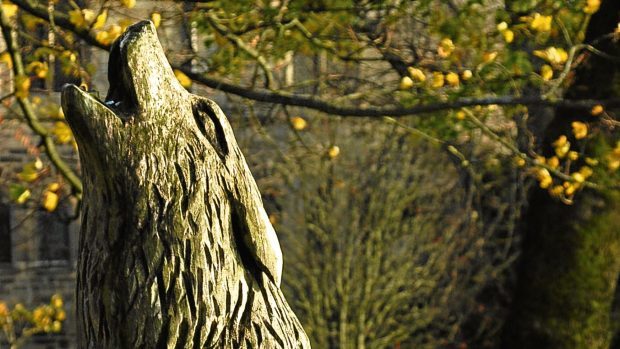Afternoon sunlight is as likely as anything to put an end to a writing shift. So when the day stirred itself from its stupor of gloom, I took a camera and a notebook for a walk.
As long as I have a notebook it doesn’t feel like I have clocked off early. Besides, it is one of the perks of the job that the writer – and only the writer – gets to decide how many hours he writes on any one day.
As cities go, Stirling has four things going for it. It is small, it has the best castle in Scotland, it has views to the mountains, and it has a wolf. I decided to visit the wolf. I found it nicely lit from behind by low afternoon sun, perched on a tree stump and howling.
The wolf is howling because it is always howling and it is perched on a tree stump because it used to be a tree. You could say that the sculptor who fashioned it (deftly wielding a chainsaw) liberated it from the tree trunk where it had always been incarcerated. The symbolism, for a nature writer who believes in reintroducing the wolf into its historic Scottish homeland, is irresistible.
The woodland where you find this wolf extends from the castle almost into the centre of the city along the steep, south-facing flank of the castle rock. When some trees had to be felled a few years ago, the enlightened decision was taken to leave enough of the doomed tree trunks standing to let the sculptor carve a few symbols of the city’s story.
Viking army
The wolf is the best of them. If you ever have cause to look at the Stirling coat of arms, you will find the wolf there. There is, of course, a story, and like all wolf stories, it bears as much resemblance to reality as hobbits and fairies at the bottom of your garden.
But the story goes that somewhere around the ninth or 10th centuries, a Viking army decided to attack Stirling at night. They had reached a nearby rock (now long gone) called the Wolf Craig where the guards had fallen asleep. Just as havoc was about to be wreaked, a wolf either barked or howled (it varies with the story-teller) to show its displeasure at the invaders and woke the guards who roused the garrison who beat off the intruders. So for more than 1,000 years now, Stirling has honoured the wolf.
You might think it is a strange city that hitches its coat of arms to a fairy story, but in the absence of the real thing anywhere in Scotland for more than 200 years now and counting (let’s not confuse wolves in zoos with the real thing), I choose to believe that any way of acknowledging the significant presence of the wolf in the landscape of our history is a good thing.
And given that Stirling is also the administrative centre for a substantial tract of mountain and forest country as far north as Glen Dochart and including Balquhidder and the Trossachs, the symbolism is perhaps more appropriate than it seems, for much of that land was once prime wolf country and there is no reason other than our widespread belief in fairy stories why it could not accommodate wolves tomorrow.
Heartland forest
Part of this landscape is also the setting for the Great Trossachs Forest, a project created by a partnership of conservation organisations and the Forestry Commission on a scale with enormous potential for wildlife, and with the happy by-product of bringing people and nature closer together.
These ideals also underpin the Heart of Scotland Forest project in Perthshire, also achieved by a similar partnership, and in which existing forests are to be connected with new planting to create a single forest reaching from Loch Rannoch to Loch Tay.
This means that two of the nation’s most ambitious forest projects will be almost within touching distance of each other, and just one more, small area of planted native woodland would connect them. This, in turn, means the rebirth of a spectacular heartland forest right through the middle of Scotland, and no terrain anywhere in the land is more suited to the reintroduction of wolves.
So when I take the lingering thoughts of my day’s work out into the afternoon sunshine with a camera and notebook, pause by the wolf with the camera, then head for a seat in the sun with the notebook to write down what’s going on in my head, I think there are worse places to spend an afternoon and worse ways to spend it. But from time to time I catch myself wondering what really did happen that night more than 1,000 years ago and why it generated such a tenacious myth.
